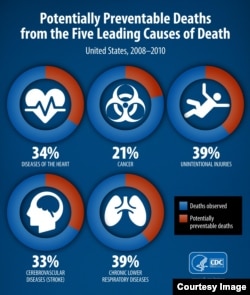Five things kill the majority of the nearly 900,000 Americans who die prematurely each year, according to the Centers for Disease Control (CDC).
Premature death, as defined by the CDC, is under 80 years old, given that the average life expectancy in the U.S. is 79.
The five top killers are heart disease, cancer, chronic lower respiratory disease, stroke and unintentional injuries. These accounted for 63 percent of all U.S. deaths in 2010 though the rates vary greatly by state.
Of those deaths, the CDC says 20 to 40 percent could be prevented if people had access to the top preventative care available in the country for each specific cause of death, a best-case scenario of sorts.
The best-case scenario was calculated by calculating the mortality rates of the five top causes of death in all the U.S. states. The three states with the lowest mortality for each of the five top killers was then averaged.
The CDC study estimated the number of avoidable, premature deaths for each cause would be as follows:
Those numbers, the CDC said, could not be added together because some people might recover from a heart attack only to later die from cancer, for example.
The CDC data covered 2008 to 2010.
“As a doctor, it is heartbreaking to lose just one patient to a preventable disease or injury – and it is that much more poignant as the director of the nation’s public health agency to know that far more than a hundred thousand deaths each year are preventable,” said CDC director Tom Frieden, MD in a statement.
The southern states, Alabama, Florida, Georgia, Kentucky, Mississippi, North Carolina, South Carolina and Tennessee, saw between 28 and 33 percent of preventable premature deaths, the CDC said.
"This data is yet another demonstration that when it comes to health in this country, your longevity and health are more determined by your [postal] code than they are by your genetic code," Frieden said during a news conference.
Ways to lower the risk of premature death include many common sense steps.
For example, the CDC recommends eating healthy, exercising, avoiding smoking, using seatbelts, using helmets, controlling high blood pressure and avoiding exposure to harmful chemicals and other substances.
Frieden told reporters that the “good news is that things that people can change -- what we call modifiable risk factors -- make a huge difference."
According to a 2009 World Health Organization report, the top causes of premature death worldwide are poor childhood nutrition, unsafe sex, alcohol use, lack of safe water, bad sanitation and hygiene, and high blood pressure.
Premature death, as defined by the CDC, is under 80 years old, given that the average life expectancy in the U.S. is 79.
The five top killers are heart disease, cancer, chronic lower respiratory disease, stroke and unintentional injuries. These accounted for 63 percent of all U.S. deaths in 2010 though the rates vary greatly by state.
Of those deaths, the CDC says 20 to 40 percent could be prevented if people had access to the top preventative care available in the country for each specific cause of death, a best-case scenario of sorts.
The best-case scenario was calculated by calculating the mortality rates of the five top causes of death in all the U.S. states. The three states with the lowest mortality for each of the five top killers was then averaged.
The CDC study estimated the number of avoidable, premature deaths for each cause would be as follows:
- 34 percent of premature deaths from heart diseases, potentially extending about 92,000 lives
- 21 percent of premature cancer deaths, potentially extending about 84,500 lives
- 39 percent of premature deaths from chronic lower respiratory diseases, potentially extending about 29,000 lives
- 33 percent of premature stroke deaths, potentially extending about 17,000 lives
- 39 percent of premature deaths from unintentional injuries, potentially extending about 37,000 lives
Those numbers, the CDC said, could not be added together because some people might recover from a heart attack only to later die from cancer, for example.
The CDC data covered 2008 to 2010.
“As a doctor, it is heartbreaking to lose just one patient to a preventable disease or injury – and it is that much more poignant as the director of the nation’s public health agency to know that far more than a hundred thousand deaths each year are preventable,” said CDC director Tom Frieden, MD in a statement.
The southern states, Alabama, Florida, Georgia, Kentucky, Mississippi, North Carolina, South Carolina and Tennessee, saw between 28 and 33 percent of preventable premature deaths, the CDC said.
"This data is yet another demonstration that when it comes to health in this country, your longevity and health are more determined by your [postal] code than they are by your genetic code," Frieden said during a news conference.
Ways to lower the risk of premature death include many common sense steps.
For example, the CDC recommends eating healthy, exercising, avoiding smoking, using seatbelts, using helmets, controlling high blood pressure and avoiding exposure to harmful chemicals and other substances.
Frieden told reporters that the “good news is that things that people can change -- what we call modifiable risk factors -- make a huge difference."
According to a 2009 World Health Organization report, the top causes of premature death worldwide are poor childhood nutrition, unsafe sex, alcohol use, lack of safe water, bad sanitation and hygiene, and high blood pressure.







